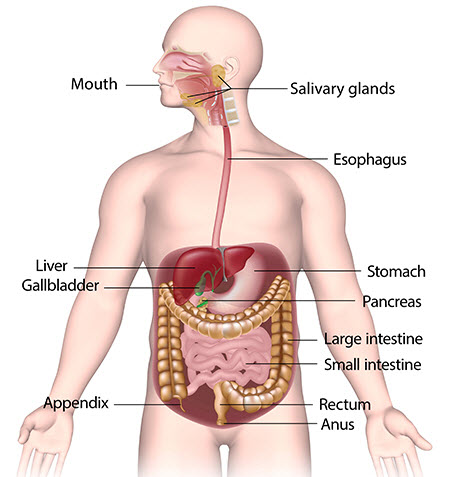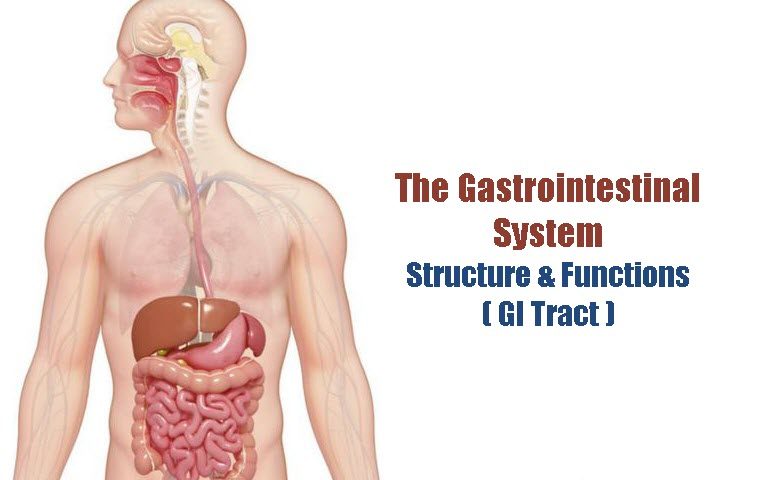The Gastrointestinal (GI) System is simply a body’s food processing complex.
The main function of the Gastrointestinal System is to derive essential nutrients including proteins, vitamins, carbohydrates, etc., from the food by processing it and supplying them to other organs and body systems for their proper functioning.
The GI system has two major components. They include:
- Gastrointestinal Tract (GI Tract) or Alimentary Canal
- The Accessory Glands and Organs
Here in this article, we will discuss the “Gastrointestinal Tract”. The accessory glands and organs will be discussed in our later post.
Gastrointestinal Tract

Coming to the structure of the GI tract, It is a hollow muscular tube that is approximately 30 inches or 9 meters long.
The GI tract extends from Mouth to Anus. It includes the following parts
- Mouth
- Esophagus
- Stomach
- Small Intestine
- Large Intestine
- Anus
Let’s have a little discussion of each of it
Mouth and Esophagus
Whenever a person smells, tastes, chews or thinks of food, the gastrointestinal system gets activated and starts doing work.
The digestive process starts with the first bite that occurs in the mouth. Chewing and salivation softens the food with which it easily get swallowed.
An enzyme in saliva known as “Ptyalin” begins to convert sugars into starches even before food is swallowed.
When the person swallows, the upper esophageal sphincter relaxes thereby allowing the food to enter into esophagus.
In the esophagus, the glossopharyngeal nerve stimulates the peristaltic waves which helps in passing of food from esophagus into stomach or we can say peristaltic waves propel the food towards stomach.
Stomach
The process of digestion occurs in 2 major phases
- Cephalic Phase
- Gastric Phase
Cephalic Phase
The cephalic phase begins early by the time when the food is moving through esophagus on its way to the stomach.
In the cephalic phase, the stomach secrets Hydrochloric acid, Pepsin and Disgestive Juices that hepls in breakdown of the food.
Gastric Phase
The gastric phase begins when the food passes through cardiac sphincter, a circle of muscle at the end of esophagus. Here in this phase, the food exits the esophagus and enters into stomach. This will lead to distension of the stomach wall.
The entry of food stimulates the mucosal lining of the stomach to release the hormone called “Gastrin“
The main role of Gastrin is
- Stimulation of gastric juice secretion
- Stimulation of Stomach’s Motor Functions
Gastric Juice
Gastric juice is highly acidic in nature with a pH of about 2.
The main components of gastric juice are
- Hydrochloric Acid
- Pepsin
- Intrensic Factor
- Proteolytic Enzymes
Hydrochloric acid helps in killing the bacteria that enters into the stomach along with the food.
Pepsin is an endopeptidase that helps in breakdown of proteins into smaller peptides.
Intrensic Factor helps the body in absorbing Vitamin B12 from the food.
Proteolytic Enzymes helps the body in making use of proteins by breaking them down into peptides.
The gastric juice mixes with the food thereby making it a thick, gruel like material called “Chyme“.
The 3 major motor functions of stomach are as follows
- Helps in holding food
- Helps in mixing the food with gastric juice by peristaltic contractions
- Helps in slowly emptying of chyme (processed food with gastric juice) into the small intestine for further digestion and absorption



